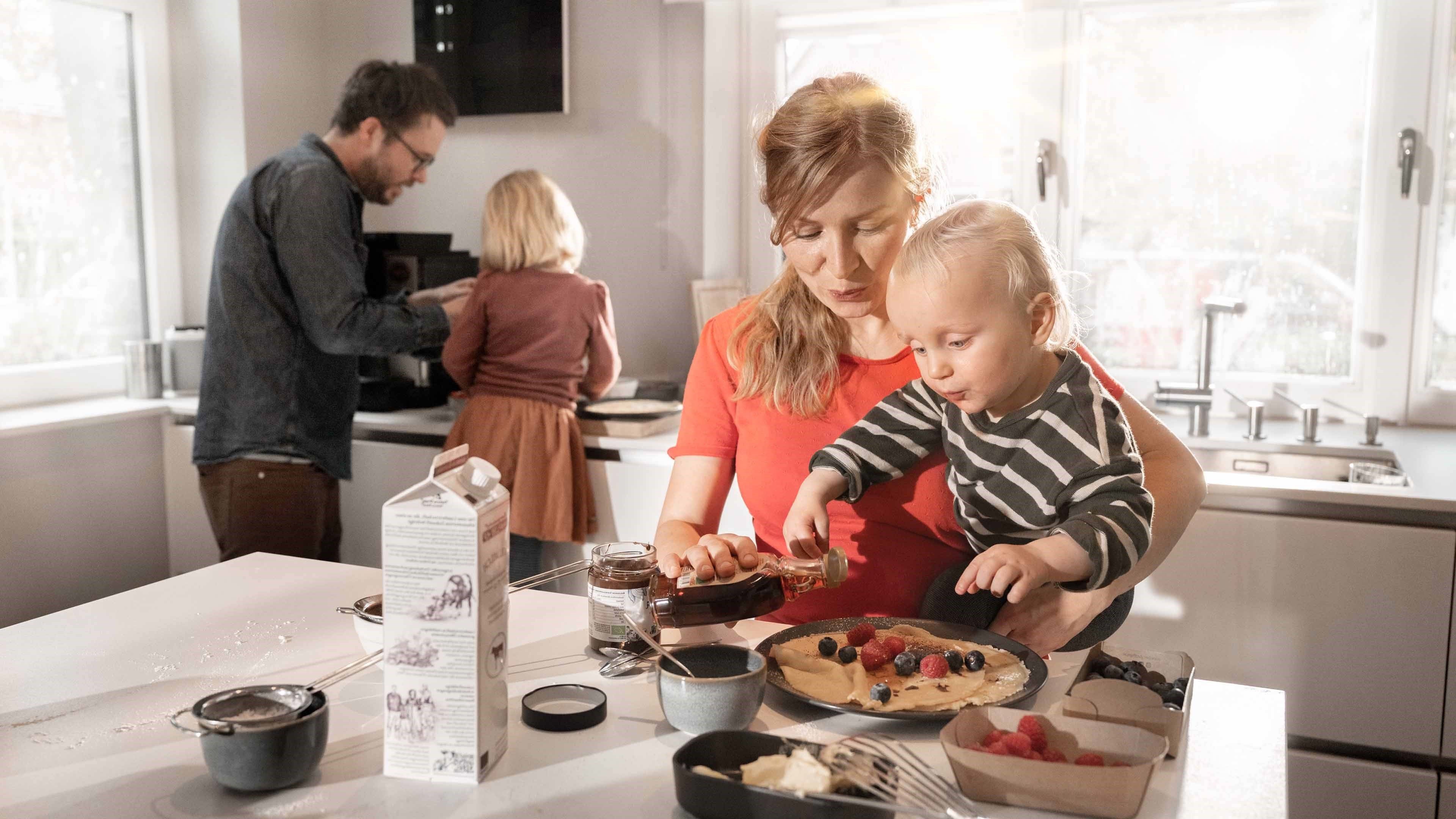The birth of a child, divorce or buying a home – far-reaching changes are a regular part of family life. And they can turn family life upside down – from a financial perspective as well. That’s why it’s important that your financial situation keeps up with these changes at all times.
How families keep track of their expenses
Children enrich our lives, but they also cost money. We provide an overview of the costs you have to expect in order to avoid any unpleasant surprises and look to the future with financial confidence.
Having children changes everything – including your family budget: if you reduce your level of employment, part of your family’s income will disappear. In addition, a young family will incur high childcare costs, and they may still want to put some money aside for holidays or their children’s education.
Children need clothes, food, and money for their free time, holidays and education. For example, a newborn child adds around CHF 300 to CHF 400 per month to a family budget, according to Budgetberatung Schweiz. And these costs rise as the child grows older: children between the ages of 7 and 12 need around CHF 500 to 560. The most expensive are children aged 13–18: depending on the form of education they are in, they can cost CHF 650–800 per month extra. Paying for a university degree is also more expensive than vocational training that pays an apprentice’s salary.
Each additional child represents an additional financial burden, but compared to the first child, the costs are lower.
For low-income families in particular, having children can be financially challenging: the average cost of a child by the time they reach their 20th birthday is in the region of CHF 200 000. And these are only the direct costs of clothing, food and personal care, leisure activities and spending money – they do not include additional expenses, such as dental work, hobbies or mobile phones. That’s why it’s a good idea to keep an eye on your family budget. Doing so allows you to quickly work out which additional costs you can avoid.
While these are average figures, each individual household budget is different. You can use the Swiss Life budget calculator to work out exactly what you can expect your children to cost you in future.
You can save up to CHF 2000 in taxes each year with pillar 3a – private tax-qualified provisions. Take care of yourself and your family at the same time.
Your tax benefits at a glance:
- You can deduct pillar 3a contributions from your income.
- Pillar 3a assets, including income, are exempt from taxation until you retire.
- When it is paid out, the 3a capital remains distinct from other income and is taxed at a lower rate.
Use the Swiss Life tax calculator to determine how much you can save in taxes with pillar 3a.
Arrange a consultation
Would you like to save and be financially self-determined? We would be happy to help. Together we can analyse your family’s financial situation and determine your savings potential.
How to calculate a family budget
Taxes, health insurance, rent or mortgage: these are just some of the things that account for a significant portion of your fixed costs and can have a huge impact on your budget. With our practical calculators, you can always keep an eye on your finances – try them now!
Budget calculator
Use the budget calculator to get an overview of your income and expenses, and calculate your savings potential.
Tax calculator
Calculate how much tax you can save with pillar 3a by using the Swiss Life tax calculator.
Part-time calculator
Use the part-time calculator to find out what effect a reduced level of employment would have on your finances.
How families can plan to be financially secure
There are a number of things you need to bear in mind when it comes to financial provisioning for the whole family. We provide you with answers to the most important questions and show you what you can do to ensure that your pension and financial situation always keeps pace with the changes in your family life.
Illness, an accident or disability can have an especially serious financial impact if a family’s main breadwinner is affected. While employees are protected against the financial consequences of an inability to work and receive a disability pension after a certain amount of time, at 60 percent of their previous income, this isn’t enough to maintain their accustomed standard of living. Disability insurance can help you close this income gap.
If you were employed when you gave birth, maternity leave has no impact on your occupational provisions. You will receive a replacement income through the ordinance on indemnity for loss of earnings (EO) or a maternity allowance (MSE). In addition, you will continue to be insured through the second pillar and can expect pension fund benefits as well. In the event of the disability or death of one of the parents, your child will be financially protected thanks to a child’s pension or an orphan’s pension. The only event for which there are no benefits is if a child becomes disabled. You should obtain additional cover for your child for this risk if possible.
Less work means lower post-employment benefits. Your retirement assets will be lower, as will your pension. You can fill the gaps in your occupational provisions – for example, with a 100% tax-deductible pension fund purchase. You can also save for old age with pillar 3a while protecting yourself further against disability and death.
If you stop working entirely in order to care for your children, then this will have an even greater impact on your pension provisions. When you are older, or if you become disabled or die, you will only receive benefits from the first pillar in the form of an AHV or IV pension – unless you have some pension capital saved in the second pillar when you stop working.
First pillar (AHV/AVS)
In a household in which the parents are an unmarried couple and one person takes care of the house while the other works, then only the employed partner is paying AHV/AVS contributions. The partner without an income or with a low income will therefore receive only a small pension. The unemployed partner will also go empty-handed in the event of death, as there will be no AHV/AVS pension. Only the children will receive an orphan’s pension in the event of the death of the mother or father.
This is what you should do:
- The non-employed partner should also make uninterrupted AHV contributions – and they should do so even when they are not working.
- For children under age 16, the social security administration office provides a child-rearing credit each year. Have this deposited in the account of the non-employed parent.
- Conclude life insurance as financial protection in the event of the death of the cohabiting partner.
Second pillar (BVG/LPP)
Occupational provisions are organised separately in the case of cohabiting partners. If the couple separate, the assets are not divided as they are with spouses, and there is no entitlement to a pension from the partner’s pension fund. In the event of one person’s death, the surviving partner has no statutory entitlement to the deceased partner’s pension. However, some pension funds offer special rules, even if they are not obliged to do so.
This is what you should do:
- Ask your pension fund if there is generally an entitlement to benefits in the event of one partner’s death.
- Find out about the exact terms and conditions at an early stage.
- Draw up a common-law partnership contract as proof of the partnership for the pension fund.
Third pillar
Pillar 3a
Cohabiting partners have no entitlement to their partner’s pillar 3a assets in the event of separation. In the event of death, the partner’s assets are distributed in accordance with matrimonial property and inheritance rights. Accordingly, the cohabiting partner and any children they had with the deceased will rank second behind the individual’s spouse if they have not yet been legally divorced. If there are no children from a previous marriage and no previous spouse, then pillar 3a is very suitable as a pension provision for cohabiting couples.
Pillar 3b
With pillar 3b, any entitlements are based entirely on inheritance law. Beneficiaries can be chosen freely, although it is necessary to take account of the statutory compulsory portions. Unmarried partners will go empty-handed if they are not included in the will.
This is what you should do:
- Pillar 3a: notify your bank or insurance company in writing who your partner is and that they are the beneficiary. Record this information in your will to be on the safe side.
- Pillar 3b: draw up a will in order to provide security for your partner in the event of your death.
Your needs – our expertise
There is a wide range of issues you may have relating to financial provisioning. We will support you with our many years of expertise. For financial confidence and a self-determined life – today, tomorrow and beyond.
“Everything for your family” magazine
From pension provisions to planning your future: in our magazine you will find lots of practical tips and helpful information on family budgets, home ownership and private provisions.
How to get your dream family home
A house with a garden and a view, and a separate room for each child: many families dream of a self-determined life in their own home. We would be happy to support you in making your plans with our comprehensive advice and valuable information on home ownership.










